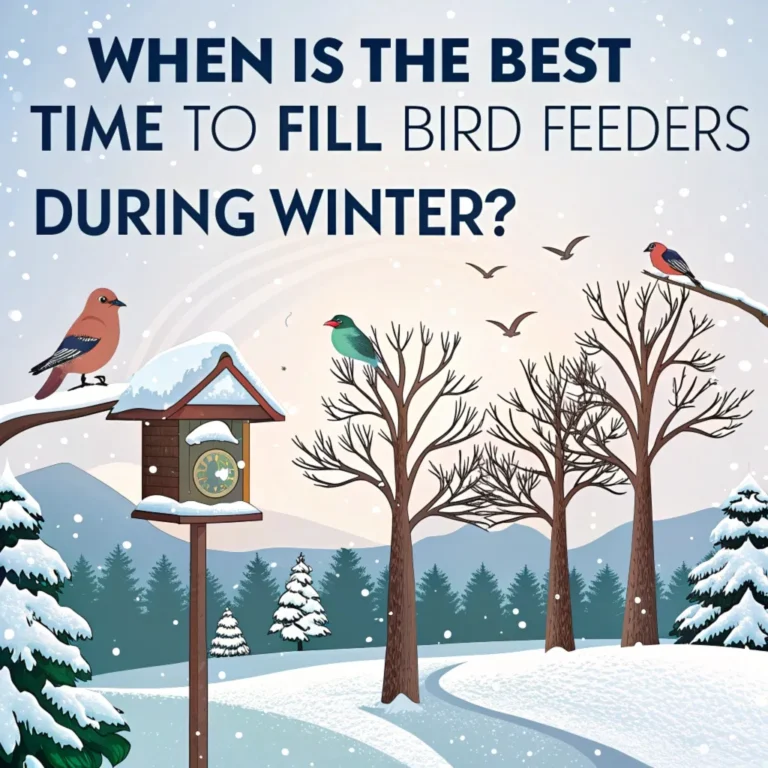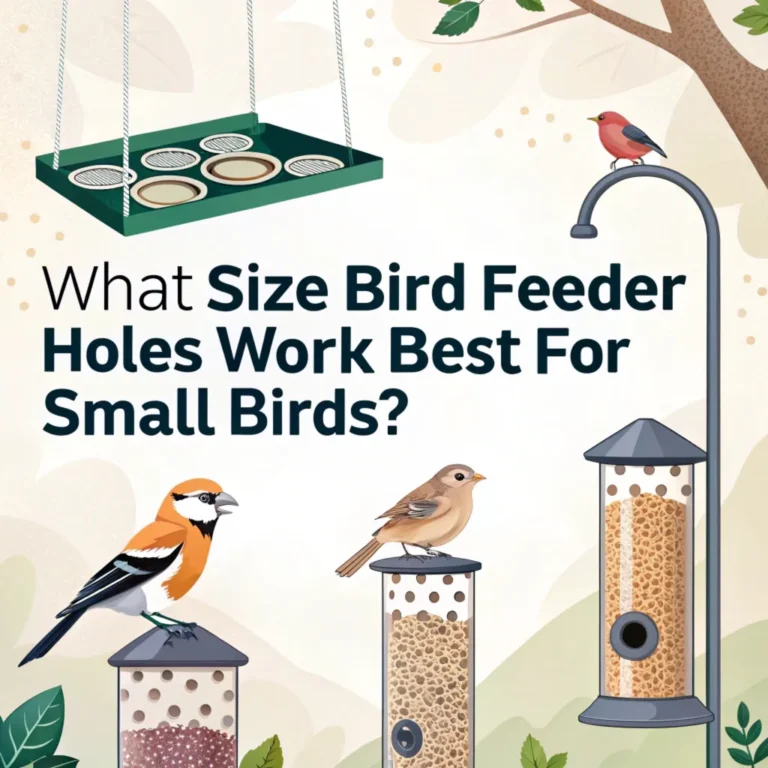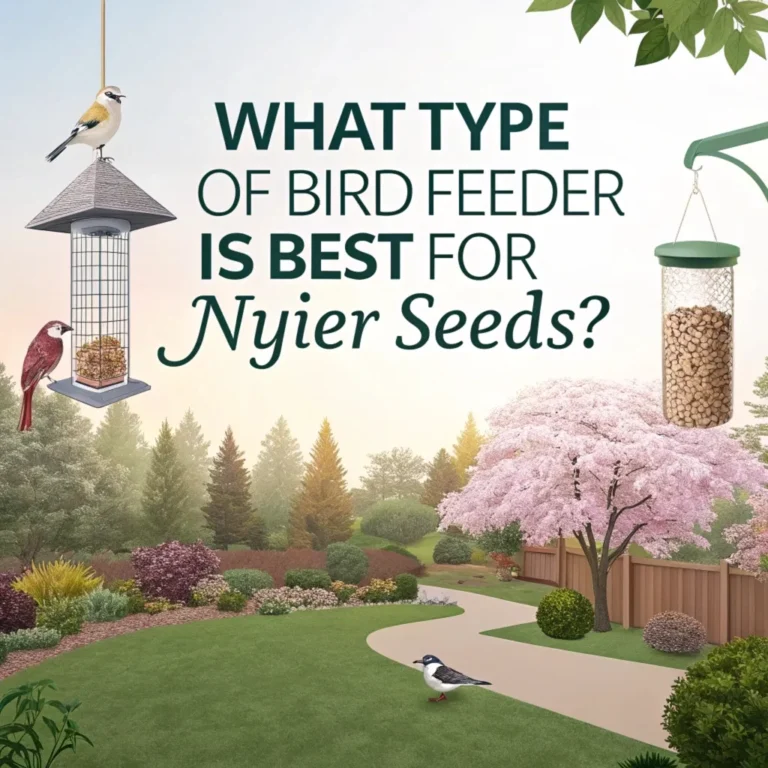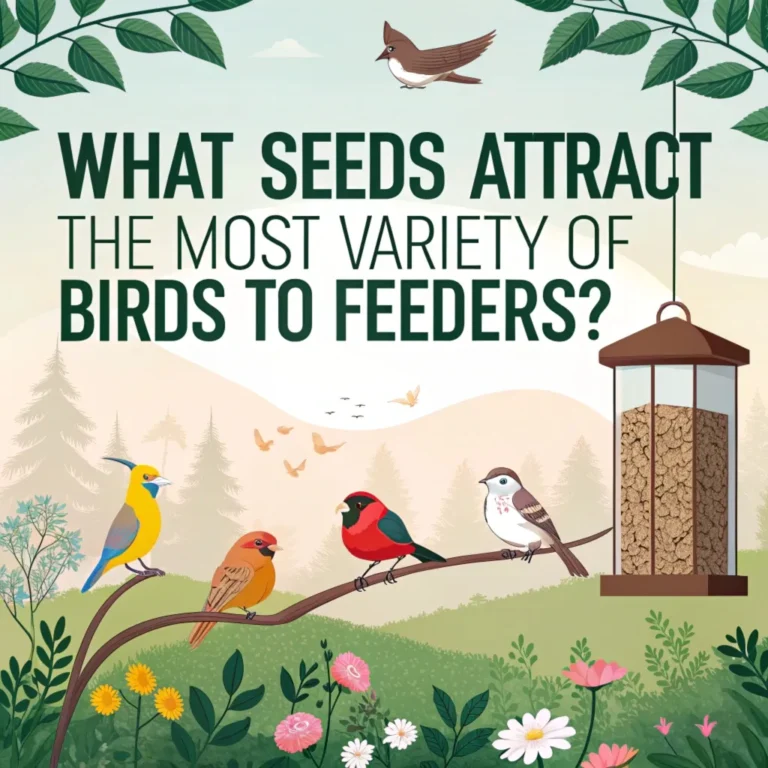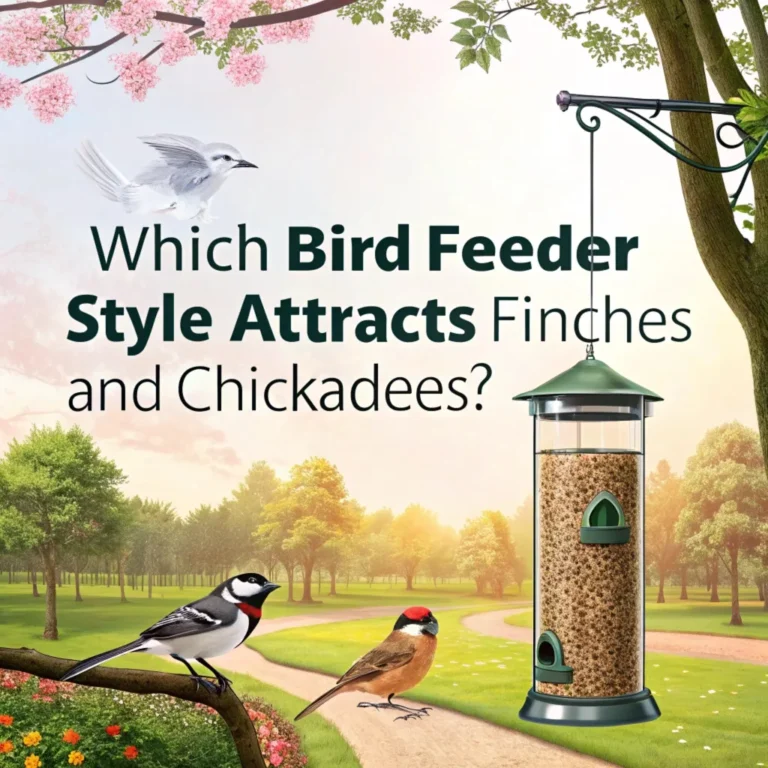Which Bird Feeder Design Prevents Seed From Getting Wet?
Bird feeding enthusiasts often face the challenge of keeping seeds dry during wet weather.
Wet seeds can spoil quickly, leading to waste and potential health risks for birds.
This comprehensive guide explores the best bird feeder designs that prevent seeds from getting wet, ensuring your feathered friends have access to fresh, dry food year-round.

Key Takeaways: Keeping Bird Seeds Dry
- Hopper feeders with wide roofs offer excellent protection from rain
- Tube feeders with covered ports keep seeds dry and accessible
- All-weather feeders feature specialized designs for maximum water resistance
- Proper drainage is crucial for preventing seed spoilage
- Regular cleaning helps maintain feeder hygiene and seed quality
- Squirrel-proof feeders often have added weather protection features
- Placement of feeders under eaves or sheltered areas provides extra protection
- Storage of excess seed in airtight containers preserves freshness
- Monitoring seed levels and condition ensures timely refills and replacements
- Choosing the right seed type can impact moisture resistance
Keeping bird seeds dry is essential for maintaining a healthy and vibrant backyard bird population. By implementing effective strategies and choosing the right feeder designs, you can ensure that your feathered visitors always have access to fresh, nutritious food.
This not only supports their well-being but also enhances your bird-watching experience.
Bird feeding is a rewarding hobby that connects us with nature. By taking steps to protect seeds from moisture, we create a reliable food source for birds throughout the year, fostering a thriving ecosystem in our own backyards.
Hopper Feeders: A Classic Choice for Dry Seeds
Hopper feeders, also known as “house” feeders, are a popular option for keeping bird seed dry. These feeders typically feature a wide roof that extends beyond the seed container, providing excellent protection from rain and snow.
Key features of hopper feeders include:
- Large capacity for holding several days’ worth of seed
- Roof design that shields seeds from direct precipitation
- Attractive to a wide variety of bird species
While hopper feeders offer good protection, they can be challenging to clean thoroughly. Regular maintenance is essential to prevent seed spoilage and ensure bird health.
Hopper feeders have been a staple in bird feeding for decades, and for good reason. Their design not only keeps seeds dry but also mimics the appearance of small houses, making them an attractive addition to any garden or backyard.
The extended roof provides ample coverage, ensuring that even during heavy rainfall, the seeds remain protected.
Maintenance is key to the longevity and effectiveness of hopper feeders. While cleaning can be more challenging due to their design, regular upkeep ensures that birds have access to fresh, uncontaminated food, promoting their health and encouraging frequent visits to your feeding station.
Tube Feeders: Sleek and Efficient
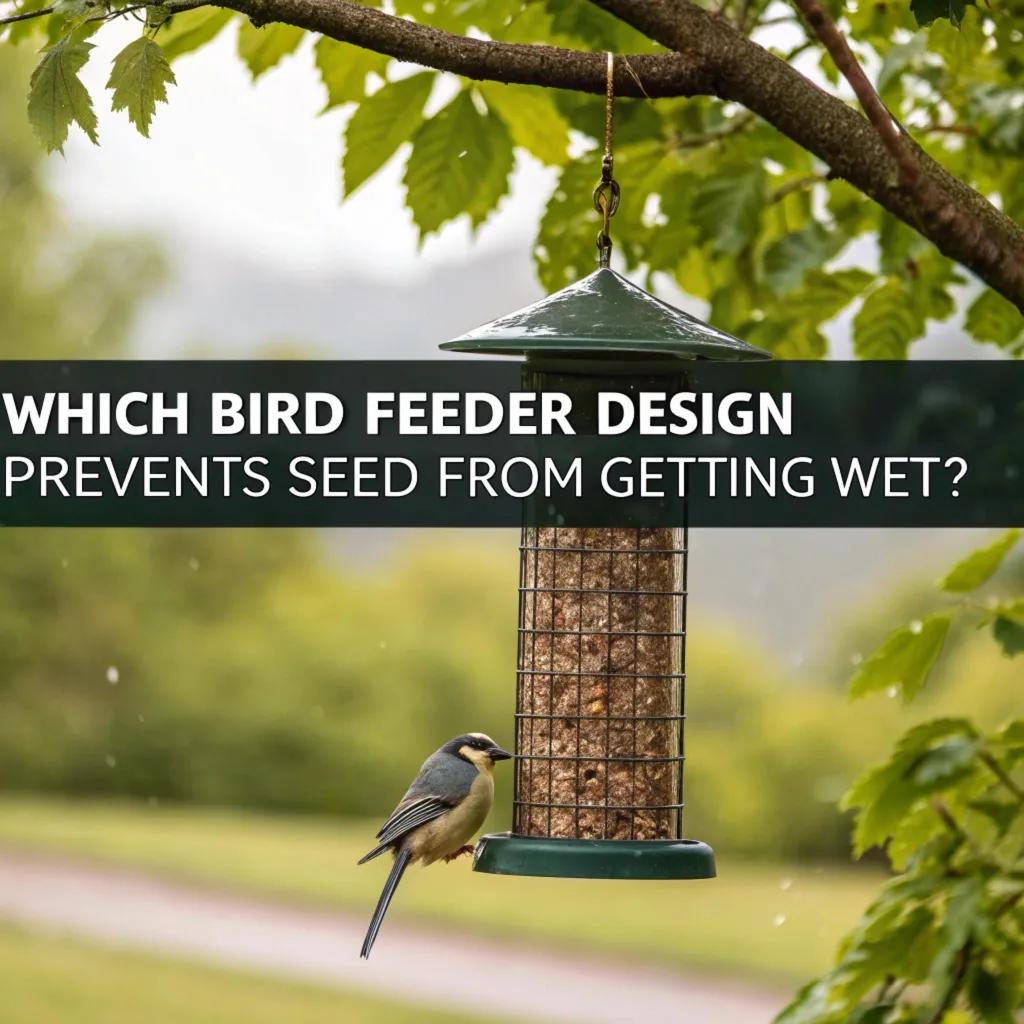
Tube feeders are another excellent choice for keeping seeds dry. These cylindrical feeders often have small, covered ports that birds access from below, minimizing exposure to rain.
Advantages of tube feeders:
- Keep seeds clean and dry while allowing easy access for birds
- Versatile design suitable for various seed types
- Often feature multiple feeding ports for several birds
Some tube feeders come with additional features like rain guards or extended roofs for extra protection against wet weather.
Tube feeders are particularly effective in areas with frequent light rain or drizzle. Their vertical design allows water to run off easily, while the small feeding ports prevent moisture from entering the seed reservoir.
This design not only keeps seeds dry but also helps control the flow of seed, reducing waste and spillage.
Customization options for tube feeders are plentiful, allowing bird enthusiasts to tailor their feeding stations to attract specific species or accommodate different types of seed. This versatility makes tube feeders a popular choice for both novice and experienced bird watchers.
All-Weather Feeders: Designed for Maximum Protection
All-weather feeders are specifically engineered to withstand various weather conditions, including heavy rain and snow. These feeders often incorporate innovative designs to keep seeds dry.
Characteristics of all-weather feeders:
- Covered feeding ports that birds access from underneath
- Excellent drainage systems to prevent water accumulation
- Durable materials that resist weather damage
One example is the All Weather Feeder, which features a circular slot under a covered port, allowing birds to pull seeds while keeping them sheltered from rain.
All-weather feeders represent the pinnacle of bird feeder design when it comes to protecting seeds from moisture. These feeders are built to withstand not just rain, but also snow, sleet, and strong winds, ensuring that birds have access to food even in the harshest conditions.
The innovative designs often incorporate multiple layers of protection, from water-resistant materials to cleverly positioned feeding ports.
Durability is a key feature of all-weather feeders. Constructed from high-quality, weather-resistant materials, these feeders are designed to last for years, making them a wise investment for serious bird enthusiasts.
Their robust construction also helps deter squirrels and other pests, providing an added layer of protection for the seeds.
Drainage: A Critical Feature for Dry Seeds
Proper drainage is crucial for any bird feeder to prevent water accumulation and seed spoilage. Look for feeders with these drainage features:
- Screened bottoms that promote complete drainage
- Multiple drainage holes in the base of the feeder
- Elevated seed trays that keep seeds away from collected water
Some bird enthusiasts modify their existing feeders by drilling additional drainage holes or adding a layer of gravel to improve water flow.
Effective drainage is often overlooked but is crucial in maintaining dry, fresh seeds. Even the best-designed feeder can become a breeding ground for mold and bacteria if water is allowed to accumulate.
Good drainage ensures that any moisture that does enter the feeder is quickly expelled, preserving the quality of the seeds and protecting the health of visiting birds.
DIY modifications can significantly improve the drainage of existing feeders. Simple adjustments, such as adding small holes or incorporating a layer of pebbles at the bottom of the feeder, can make a big difference in keeping seeds dry and fresh.
Cleaning and Maintenance: Essential for Feeder Health

Regular cleaning is vital for keeping bird feeders in good condition and preventing seed spoilage. Follow these cleaning tips:
- Clean feeders at least once every two weeks, more often in warm weather
- Use a mild soap and water solution for routine cleaning
- For stubborn dirt, use a solution of one part vinegar to four parts water
- Rinse thoroughly and dry completely before refilling
Proper cleaning helps prevent the growth of mold and bacteria that can harm birds.
Maintaining clean feeders is not just about keeping seeds dry; it’s about ensuring the overall health of the birds visiting your yard.
Regular cleaning prevents the buildup of harmful bacteria and mold that can cause diseases in birds. This practice is especially important during wet seasons when moisture can accelerate the growth of pathogens.
Establishing a cleaning routine is key to successful bird feeding. By incorporating regular feeder maintenance into your schedule, you create a safe and inviting environment for birds, encouraging them to return to your yard time and time again.
Squirrel-Proof Feeders: Added Protection
Many squirrel-proof feeders offer additional benefits for keeping seeds dry. These feeders often feature:
- Covered feeding ports that close under a squirrel’s weight
- Weather baffles that serve dual purposes of deterring squirrels and blocking rain
- Durable construction that resists both animal and weather damage
While primarily designed to deter squirrels, these features can significantly contribute to keeping seeds dry.
Squirrel-proof feeders offer a dual advantage in bird feeding. Not only do they protect seeds from hungry squirrels, but their design often incorporates features that excel at keeping seeds dry.
The covered ports and weather baffles that deter squirrels also serve as effective barriers against rain and snow, ensuring that the seeds remain dry and fresh.
Investing in a squirrel-proof feeder can be a cost-effective solution for bird enthusiasts dealing with both moisture and squirrel problems.
These feeders are typically built to last, with durable materials that stand up to both weather and persistent wildlife, making them a smart choice for long-term bird feeding success.
Strategic Placement for Extra Protection
The location of your bird feeder can greatly impact how well it keeps seeds dry. Consider these placement strategies:
- Under eaves or overhangs for natural shelter
- Near dense shrubs or trees that provide some cover
- Away from sprinklers or other water sources
Proper placement can complement the feeder’s built-in weather resistance features.
Thoughtful placement of bird feeders can significantly enhance their ability to keep seeds dry. By taking advantage of natural shelters in your yard, you can create a feeding station that remains protected even during inclement weather.
This strategic approach not only keeps seeds dry but also provides birds with a safe and comfortable feeding environment.
Considering the surrounding landscape when placing feeders can offer additional benefits. Nearby trees or shrubs can provide birds with quick escape routes and resting places, making your feeding station more attractive and frequently visited.
Seed Storage: Preserving Freshness
Proper storage of excess seed is crucial for maintaining its quality. Follow these storage tips:
- Use airtight containers to store bulk seed
- Keep containers in a cool, dry location
- Avoid storing seed in direct sunlight
- Check regularly for signs of moisture or pests
Good storage practices ensure that you always have fresh, dry seed available for your feeders.
Proper seed storage is an often overlooked aspect of bird feeding, but it’s crucial for maintaining seed quality and preventing waste.
By storing seeds correctly, you ensure that the food you provide to birds is always fresh and nutritious, maximizing the benefits of your bird feeding efforts.
Regular inspections of stored seeds can help catch potential problems early. By checking for signs of moisture or pest infestation, you can prevent spoiled seeds from making their way into your feeders, protecting the health of visiting birds and avoiding unnecessary waste.
Monitoring Seed Condition
Regular monitoring of seed condition in your feeders is essential. Look out for:
- Clumping or caking of seeds, which indicates moisture
- Discoloration or unusual odors that may signal spoilage
- Sprouting seeds, which occur when seeds get too wet
If you notice any of these signs, remove the affected seed immediately and clean the feeder before refilling.
Vigilant monitoring of seed condition is a critical practice for any bird feeding enthusiast.
By regularly checking the state of the seeds in your feeders, you can quickly identify and address any moisture-related issues before they become problematic.
This proactive approach ensures that birds always have access to fresh, healthy food.
Prompt action when issues are detected is key to maintaining a healthy feeding environment.
By quickly removing spoiled seeds and cleaning affected feeders, you prevent the spread of mold and bacteria, safeguarding the health of your feathered visitors.
Choosing the Right Seed Type
Some seed types are more resistant to moisture than others. Consider these options:
- Sunflower seeds with intact shells resist moisture better than shelled seeds
- Safflower seeds have a hard outer shell that provides some water resistance
- Nyjer seeds are small and can dry quickly if exposed to moisture
Selecting the appropriate seed type can help extend its freshness in your feeder.
Seed selection plays a crucial role in maintaining dry, fresh food for birds. Different types of seeds have varying levels of resistance to moisture, and choosing the right ones can significantly impact how well your feeding station withstands wet conditions.
By opting for seeds with natural moisture resistance, you can extend the time between feeder refills and reduce waste.
Experimenting with different seed types can help you find the best option for your local climate and bird population. Some seeds may be more popular with certain bird species, so consider the preferences of your feathered visitors when making your selection.
FAQs About Keeping Bird Seeds Dry
How often should I clean my bird feeder?
Clean your bird feeder at least once every two weeks. In warm or wet weather, increase cleaning frequency to once a week to prevent mold growth and seed spoilage.
Can I use a regular plastic container to store bird seed?
While plastic containers can work, it’s best to use airtight, food-grade containers specifically designed for seed storage. These containers help keep moisture and pests out, preserving seed freshness.
What should I do if my bird seed gets wet?
If your bird seed gets wet, remove it from the feeder immediately. Slightly damp seed can be spread out to dry in a sunny area, but thoroughly soaked or moldy seed should be discarded to prevent bird illness.
Are there any natural ways to keep bird seed dry in feeders?
Yes, you can add a small amount of food-grade diatomaceous earth to your bird seed. This natural powder helps absorb excess moisture and can deter insects. However, use it sparingly as too much can be harmful if inhaled by birds.
How can I tell if bird seed has gone bad?
Look for signs such as clumping, discoloration, unusual odors, or visible mold growth. If you notice any of these signs, discard the seed and clean the feeder thoroughly before refilling.
By implementing these strategies and choosing the right feeder design, you can ensure that your backyard birds have access to fresh, dry seed throughout the year. Remember, keeping bird seed dry not only reduces waste but also promotes the health and well-being of your feathered visitors.
Maintaining dry bird seed is a crucial aspect of responsible bird feeding. By implementing the strategies outlined in this guide, you can create a safe and inviting environment for birds, ensuring they have access to nutritious food regardless of weather conditions. This not only supports the health of local bird populations but also enhances your bird-watching experience.
Continuous learning and adaptation are key to successful bird feeding. As you gain experience, you’ll discover what works best in your specific environment, allowing you to fine-tune your approach and create an optimal feeding station for your feathered friends.

Luna is the passionate founder and author of Birds and You, a website dedicated to sharing her love for birds with fellow enthusiasts. Through her engaging articles and guides, she aims to educate and inspire others to explore the fascinating world of birds. When she’s not writing, you can find Luna observing birds in their natural habitats or sharing beautiful bird photography on Pinterest. Join her on this journey to celebrate and protect our feathered friends!


